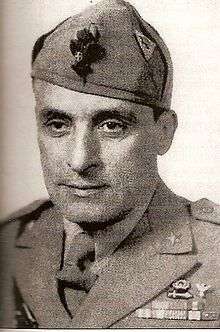Giuseppe Castellano
| Giuseppe Castellano | |
|---|---|
 | |
| Born |
September 12, 1893 Prato, Tuscany, Italy |
| Died |
July 31, 1977 (aged 83) Porretta Terme, Emilia-Romagna, Italy |
| Allegiance |
|
| Service/branch | Royal Italian Army |
| Years of service | 1913 – 1944 |
| Rank | Brigadier General |
| Battles/wars |
World War I World War II |
Giuseppe Castellano (September 12, 1893 in Prato – July 31, 1977 in Porretta Terme) was an Italian general who negotiated the Armistice between Italy and Allied armed forces on September 8, 1943.
Biography
Military career
Of Sicilian descent but born in Prato he was the son of a military man. His career in the Army was rapid and brilliant. In the First World War he was Captain of Artillery. In 1941, he was promoted to brigadier general during the Invasion of Yugoslavia, and was at that time, the youngest general in Italy. In 1942 he was called to the Army General Staff and the following year, to the High Command and collaborated as personal aide with General Vittorio Ambrosio.[1]
He was a close friend of Benito Mussolini's son-in-law Galeazzo Ciano, who was the Italian Minister of Foreign Affairs. Ciano was involved in ousting Mussolini in July 1943 after the Allied invasion of Sicily. Castellano sided with Ciano and had a prominent role in the events that led up to the fall of the fascist regime. He organised the arrest of Mussolini.[1]
Armistice with the Allied armed forces

The new Prime Minister, Pietro Badoglio, sent Castellano to Lisbon in order to contact Allied diplomats to set the conditions for the surrender of Italy. He ordered Castellano to insist that any surrender of Italy was subject to a landing of Allied troops on the Italian mainland (the Allies at this point were holding Sicily and some minor islands). Badoglio also dared to ask for access to Allied military plans, which was not accepted.[2]
After complicated negotiations the government and king accepted the conditions for the armistice. On September 3, 1943, Castellano, in lieu of Badoglio, and General Walter Bedell Smith, in place of General Dwight D. Eisenhower, signed the armistice agreement in the town of Cassibile, near Syracuse, in Sicily. The agreement was not announced until September 8, when Badoglio addressed the nation during a radio broadcast.[2][3]
Intervention in post-war Sicilian politics
After the armistice Castellano emerged as Sicily’s military commander.[4] He had been given powers to hold talks to resolve the separatist threat to Italian unity. He became convinced that the Mafia was the strongest political and social force on Sicily to be reckoned with. He started to establish cordial relations with Mafia leaders. The general believed that law and order could be restored if "the system formerly employed by the old and respected Maf(f)ia should return to the Sicilian scene."[5]
Castellano made contacts with Mafia leaders and met with them several times. He gained the cooperation of Mafia boss Calogero Vizzini, who had supported separatism but was now prepared for a change in the island’s political situation. Together with Vizzini, he approached Trapani politician Virgilio Nasi to offer him the leadership of a movement for Sicilian autonomy with the support of the Mafia. The plan was to stage Nasi as a candidate for High Commissioner for Sicily to oppose the favourite, the Christian Democrat Salvatore Aldisio.[1][6]
Castellano’s initiative weakened the Sicilian Independence Movement (Movimento Indipendentista Siciliano, MIS) of Andrea Finocchiaro Aprile. The Mafia, however, became a force of order and stability on the island and prevented a separatist overthrow by stifling extremist elements in the movement. The seeds were planted from which the Mafia would tremendously benefit in the decades to come.[7]
Retirement and death
He wrote a number of books about his experiences during the War: "Come firmai l'armistizio di Cassabile" (How I signed the armistice in Cassabile), published by Mondadori in 1945; "La guerra continua" (The continuous war); and "Roma Kaputt". In 1947, he retired from the Army and became the director of a chain of hotels and thermal baths for some years. He died in Porretta Terme on July 31, 1977.
References
- 1 2 3 (in Italian) Il generale amico di don Calò Vizzini Archived March 25, 2009, at the Wayback Machine., La Sicilia, September 10, 2003
- 1 2 Agarossi, A Nation Collapses, pp. 73-81
- ↑ Finkelstein, Separatism, the Allies and the Mafia, p. 50
- ↑ Finkelstein, Separatism, the Allies and the Mafia, p. 120
- ↑ (in Italian) Il nodo siciliano, from the 2002 final report of the Italian Parliamentary Commission on Terrorism in Italy (Commissione parlamentare d'inchiesta sul terrorismo in italia e sulle cause della mancata individuazione dei responsabili delle stragi).
- ↑ Finkelstein, Separatism, the Allies and the Mafia, p. 125
- Agarossi, Elena (2000). A Nation Collapses: The Italian Surrender of September 1943, New York: Cambridge University Press, ISBN 0-521-59199-6
- Finkelstein, Monte S. (1998). Separatism, the Allies and the Mafia: The Struggle for Sicilian Independence, 1943-1948, Bethlehem (Pennsylvania): Lehigh University Press, ISBN 0-934223-51-3